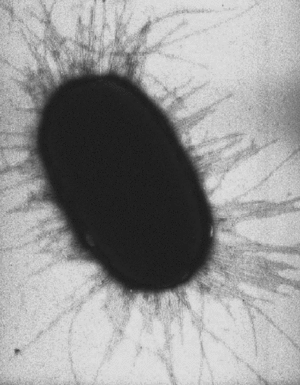Pilus
A pilus (Latin for 'hair'; plural : pili) is a hairlike structure on the surface of a cell, especially Gram-negative bacteria, a protein appendage required for bacterial conjugation. Pili connect the bacterium to another of its species and build a bridge between the cytoplasm of either cell. That enables the transfer of plasmids between the bacteria. An exchanged plasmid can add new functions to a bacterium, e.g., an antibiotic resistance.
Sometimes called a sex pilus (plural: sex pili). Up to ten of these structures can exist on the bacteria. Some bacterial viruses or bacteriophages attach to receptors on sex pili at the start of their reproductive cycle.
Despite the name "sex pilus", this has nothing to do with sexual reproduction or mating, nor is it the bacterial equivalent of a penis; such misnomers are used quite frequently in describing the process, and while may prove useful in understanding underlying concepts are misleading nonetheless.
A pilus is typically 9 to 10 nm in diameter. The pilus allows for the transfer of bacterial DNA from the bacteria with the pilus (donor) to the recipient bacteria. Through this mechanism of gene transfer, advantageous genetic traits can be disseminated amongst a population of bacteria. Not all bacteria have the ability to create sex pili, however sex pili can form between bacteria of different species.
It is an extension of the cytoplasm and used for attachment to surfaces (and is then called a fimbrium) and conjugation with another cell of the same species.
A fimbrium (Latin; plural: fimbria) (main article: fimbria) is a short pilus that is used to attach the cell to a surface. Fimbria are either located at the poles of a cell, or are evenly spread over its entire surface. Mutant bacteria that lack fimbria cannot adhere to their usual target surfaces and, thus, cannot cause diseases.
These fimbria can contain lectins. The lectins are necessary to adhere to target cells because they can recognize oligosaccharide units on the surface of these target cells. However, all types of pili are primarily composed of oligomeric pilin proteins.
Pili generate motile force via interactions with the bacteria cytoskeleton MreB which is homologous to eukaryotic actin. The process is akin to the myosin power stroke. The external termini of the pili adhere to solid substrate, and subsequent pili contraction pulls the bacteria forward, not unlike a grappling hook.
